
Plague Quarantine Page Menu: 1 2 3 4 5 6 7 8 9 10 11 12 13 14 15 Next>>
Golden Age of Piracy Maritime Quarantine For Plague, Page 5
The Mediterranean Lazarettos - Processing Incoming Ships (continued)
When the ship arrived in port, some of its documents were gathered to help verify information gathered during the interviews. The Messina instructions state that the guardian, "finding, that they [the ship] come[s] from parts where there is
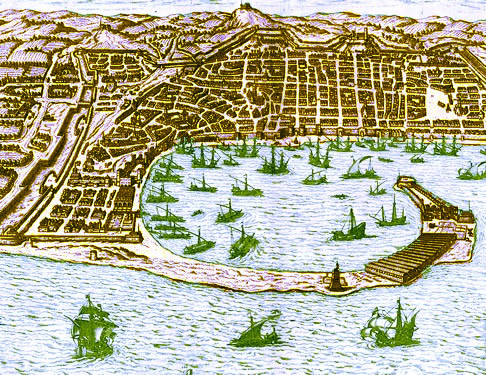
Artists: Georg Braun and Franz Hogenberg
Map of the Port of Messina, Italy - Prospectus Freti Siculi, Vol. 1 (1575)
no suspicion [of disease], nor that there is any quarantine to do, he takes the health certificates"11. When the assigned guardian who approached the ship determined that it had come from a suspicious place, he took their bills of health, which he "was not to receive by hand, so as not to cause any disorder, but using a long cane to retrieve them and then had the bills of health perfumed"12. (Perfuming of papers with scented smoke was used to eliminate any contagion. This is discussed in detail in the section 'Quarantine at the Mediterranean Lazarettos: Letters'.) This information was put into a written report and given to the Messina Bureau of Health, which examined the ship's documents and itinerary and compared them with the health status at the locations where the ship had stopped. Historian Daniel Panzac explains that the bill of health was of utmost importance in determining the fate of the ship. "This document fixes the duration and conditions of the quarantine which ships, passengers and goods which arrive from the Levant and Barbary must undergo."13
Inspections of people on a ship were usually performed to verify that those arriving were indeed as healthy as the captain and others had reported during interviews. John Howard explains that a guardian boarded his ship when they were at Venice in the 18th century to perform an inspection. 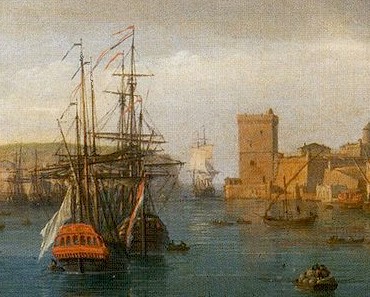
Artist: Claude-Joseph Vernet -
Interieur du port de Marseille (1754)
He explained that when the guards come aboard, "they must take an exact roll of all the ship's crew, which they transmit to the office, and they must see them all mustered every day, that no sickness be concealed, nor elopement [escape from the ship be] made."14 They were then to make sure that no one aboard left the ship until its status and quarantine duration had been determined.
It has already been noted that the 1695 Messina instructions required a guard to come aboard and perform a quick interview. Another guard was assigned to a ship who was to "assist in the transport of the goods or people which will enter the Lazaretto and when finished, must return to the vessel, & there guard it during the period established for its quarantine."15 There is no evidence that either of the guardians assigned to a ship at Messina were doctors or that they had any medical training. However, in 1728, the rules at Messina were changed so that after the information and bills of health were taken to the health officials, a "necessary re-examination by the physicians is to be carried out"16.
In his journal, 17th century sea surgeon James Yonge gives an account of an inspection at the port at Messina, Italy from January of 1665.
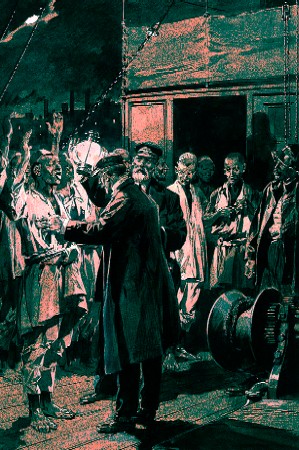
Artist: Frédéric de Haenen
A medical officer examining a ships crew for bubonic
plague, Wellcome Collection (1906)
After we had been a while there, no one suffered to come ashore, we are all hands called out of the ship and directed to a small quadrangle, where an old fellow, perusing the bill of health we had from Genoa, puts on a great pair of spectacles as big as saucers and, making each man expose his groins and armpits [for bubos, a sign of the plague], he looks into them and with a stick thrusts in them, where, finding nothing, we are allowed prattick [pratique - permission to go on land], and then went into the town. One of our men who came from Genoa with a bubo [from Gonorrhea] was quite cured, for I purged and sealed it off [probably with cautery irons], so as he was well and nothing showed but the want of hair, tho our man earnestly lookt into it and see if he could find what he suspected.17
So the inspection process was in place long before the 1728 instructions spelled out this requirement. However, from Yonge's account, the inspector's background isn't clear, even though he was looking for medical symptoms. It seems possible that this was just one of the guards who had been told what to look for. Historian Carlo Cipolla explains that
in general the Health officers had no medical background. It might be surprising but it was not absurd that people totally unacquainted with medical theory or practice would be appointed to such an office. In the main towns, the officers could consult with the College of Physicians for technical advice. The officers of the minor centres could consult with the local physicians, reported to the central Health officers of their respective capitals and received from the latter both instructions and information.18
Some accounts do indicate that these inspectors had a medical background.
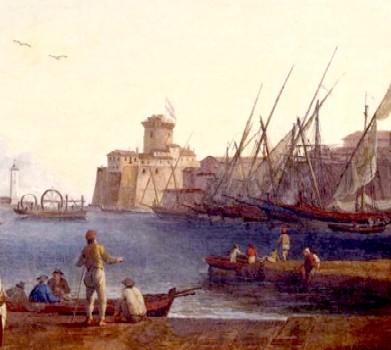
Artist: Phillip Hackert -
Port of Livorno (1778)
When navy sailor Samuel Atkins arrived at Livorno, Italy on February 7, 1682, he said, "This day being ye 22nd from our arrivall here, the Doctor of the Sanita with some other officers came to ye side, and after demanding a few impertinent questions, gave us prattick with ye Assistance and 4 Merchants."19 This doctor was likely a physician or physician's assistant. When anchored in the harbor at Cadiz, Spain, Father Jean-Baptiste Labat noted that "an ill-conditioned badly-dressed official came alongside in a boat with the Spanish flag at her stern, and forbade anyone to land before the doctors and health officers visited the ship."20
Eduardo Bueno explains that the Alicante, Spain lazaretto relied on three 'doctors' who served the city, upon arrival of a ship, provided "the sanitary inspection of the sailors in the ships verifying that there were no signs of infection among the crew. ...When the isolated ships finished their quarantine, they received another medical visit to verify that the crew was healthy."21 These 'doctors' also appear to have been physicians, because Bueno adds that "surgeons occasionally participated in the exams."22 It seems almost certain that other-mentioned inspectors had been trained to recognize signs of the plague and may even have been assistant physicians or surgeons, although this cannot be stated with certainty.
11 Instruzzioni e gouerno del lazzaretto di Messina.., 1695, p.6; 12 Instruzzioni e gouerno del lazzaretto di Messina.., 1695, p.7; 13 Daniel Panzac, Quarantines et Lazarets, 1986, p. 41 - interpreted by the author; 14 John Howard, An Account of the Principal Lazarettos In Europe, 1791, p. 17; 15 Instruzzioni e gouerno del lazzaretto di Messina.., 1695, p.7; 16 Istruzioni per il governo della deputazione di Sanita, e lazaretto della nobile, fidelissima, & esempl. citta di Messina, 1728, p. 10; 17 James Yonge, The Journal of James Yonge [1647-1721] Plymouth Surgeon, 1965, p. 75; 18 Carlo M. Cipolla, Cristofano and the Plague, 1973, p. 48; 19 Samuel Atkins, "A Sailor's Journal", Colburn's United Service Magazine, Part 3, 1854, p. 544; 20 Pere Jean-Baptiste Labat, The Memoirs of Pére Labat 1693-1705, 1970, p. 261; 21.22 Eduardo Bueno, “Safeguarding Health, Maritime Trade And Bourbon Centralism: The Case Of The Port Of Alicante In The 18th Century”, Comercio Y Cultura en La Edad Moderna, 2015, p. 1234
The Mediterranean Lazarettos - Assigning the Quarantine Period
The time that people and goods had to spend in quarantine depended on the status it was assigned. This was based on interviews with the crew, bills of health and inspections, the details of which were covered in the previous section. Ships were assigned to one of three categories: clean, suspect and foul or infected (likely or verified contamination).
A 'clean' designation meant that there was little or no suspicion of contamination. The 1695 Messina lazaretto instructions explain that when as long as a ship didn't "come from the Levant, or from a suspicious place, and they had not been sheltered anywhere where there may be a suspicion [of the plague], then it has to be given free pratique"1.

Artist: Robert Nanteuil - John Evelyn (1850)
Ships with a clean bill of health either did not have to serve time in the lazaretto once they had been certified by the board or health or served only a short time. Writing in October of 1644, John Evelyn said that when they arrived at Genoa, Italy with a clean bill of health, they anchored at the breakwater outside the city. "Toward evening we adventured, and came on shore by the Prattique-house, where, after strict examination by the Syndics [government officials], we were had to the Ducal Palace, and there our names being taken, we were conducted to our inn"2. Evelyn's case at Livorno was performed with little ceremony, their clean bill of health carrying them right off the boat and into the city. Several sailors accounts discussed later mention similar experiences where a clean bill of health resulted in no time in quarantine.
Coming from the right location was necessarily sufficient for a invitation into town without serving any quarantine, however. The Marseille Bureau of Health instructions say that even ships which "come from places not suspected [of having the plague] without bills of health will have eight days added to their quarantine."3
When a ship was designated suspect, it was felt that the ship might be contaminated, so it had to spend some time in quarantine to be sure it was free from contagion. Howard explains that when a ship was considered suspect, "the captain is re-conducted on board [his ship] with the same formality as he came [to the office to report on the status of his ship]."4 The guardian on such ships were to take a head count and note the possessions he found aboard the ship. This information was put into a report which was sent to the health office to be compared with what the vessel's captain said in his interview. Once the ship's status was officially decided, the ship's cargo and passengers would be sent to serve out their quarantine.
Quarantine periods for vessels deemed 'suspect' varied between locations. At some places, the quarantine period was the same as for those judged to be foul or infected. The 1695 Health instructions for the Lisbon, Portugal area explain that "vessels that come from suspicious places,
, Wiki Seksen iki yz kirk bez-s.jpg)
Image of Globe: Wiki User Seksen iki yüz kırk beş
as they are all from Barbaria [Barbary Coast], or others places where there was contagion, even if it is known to have ceased, the people and cloth will be quarantined, airing goods for no less than forty days; and this quarantine shall be extended by whatever the senate [of health] deems appropriate."5 The 1716 Marseille rules instructed that ships which came "from Levant or Barbary without a Bill of Health [making them 'suspect'], will make the same quarantines as those who come with foul bills of health"6. However, suspect ships were allowed to make shorter quarantines at some locations. The Marseille rules also said, "Ships coming from the same places with Suspect Bills of Health, will have to quarantine for thirty days... and those who come with foul Bills of Health, will make forty."7
Ships considered foul or infected were always required to be in quarantine for the longest period. A physician from Florence who had inspected the lazaretto at Genoa, Italy in 1652 talks about this, which he calls quarantena brutta (ugly quarantine). "The quarantena brutta derived its name from the fact that it was applied to people defined as brutti because they had caught the infection or had been in close and direct contact with infected people or merchandise. It meant complete isolation for 40 days or more, plus a further period of isolation described as 'convalescence.'"8 Professor Carlo Cipolla explains that such 'convalescence' was "intended not so much to help the convalescents in their recovery as to keep them isolated for a father period after they had been removed from the ranks of the [infected] sick."9
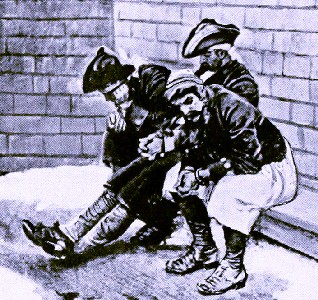
Artist: Howard Pyle (1893)
Ships with a foul or infected status were either sent away (to prevent them from violating the cordon sanitare) or, if admitted, given a full, traditional quarantine of forty days. The instructions for quarantine at Messina state 'infected' (foul) boats "should not be admitted pratique, or to quarantine, but they must immediately be ordered away, under pain of death."10 They also note that if such ships require provisions, they would be provided, following 'the usual precautions'. These appear to have been putting the provisions on land at a place far from any inhabitants where the sailors could retrieve them, being sure not to leave any "ropes, threads, pieces of cloth, or anything else infected, using due regard & attention."11 As already mentioned, foul/infected ships at Marseille had to spend 40 days in quarantine according to the 1716 instructions.
The bills of health were not the only thing used to determine how much time a ship would spend in quarantine. Part of the equation for determining the status of a ship depended on where it was coming from. John Howard says that at Venice, "ships from Zante, Cephalonia, and the other Venetian islands are always liable to a quarantine of thirty days, or three weeks at least, and frequently to forty days; because [of its'] lying so near the Morea, and having daily communication with its inhabitants"12. Venice owned Moria at the beginning of the golden age of piracy, but
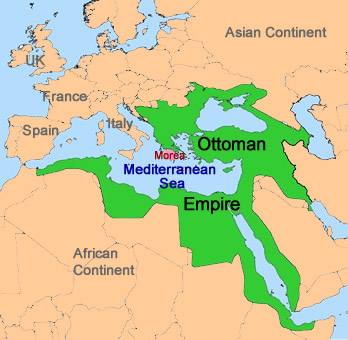
Ottoman Empire from 1691-1791, Original Image: Wiki User Esemono
the Ottoman Empire took it in 1715, long before Howard was writing. So it is probable that ships coming from those places when they were held by the Venetians did not have to perform full quarantines. However, Howard's description indicates that when he was writing in the late 18th century, such ships were treated at least as being suspect (30 days of quarantine) or sometimes as being foul (40 days).
Howard explains "that all ships and merchandise coming from any part of the Ottoman dominions, are indispensably subjected to the full quarantine of forty days; for, as the Turks take no precautions to prevent this dread fill calamity, or to preserve or deliver themselves from it"13. Howard also notes that when a ship had no bill of health at Venice, "it is the unalterable rule of the office, to oblige ship and cargo to perform full quarantine."14 So such ships were treated as foul at that time. The 1716 Marseille instructions for the bureau of health similarly state that vessels "coming from the Levant or Barbary without a Bill of Health, will serve the same quarantine periods as those who come with foul bills of health"15.
Speaking directly to the quarantine of the vessel itself (as opposed to the quarantine of the people and goods aboard), the Marseille instructions had rules about quarantine periods for those coming from Constantinople or Barbaria. Ships with clean bills of health coming from were to be
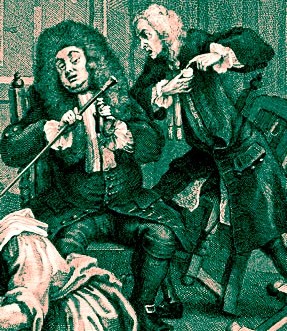
Artist: William Hogarth (1732)
quarantined for twenty days, measured from when the last of their goods had entered the lazaretto. As noted previously, those with suspect bills were required to perform thirty days quarantine and those with foul/infected bills were quarantined for forty. Even those from the Ottoman empire or Morea with clean bills were to be quarantined for sixteen days while those with foul bills were quarantined for forty.16
In addition to differences in quarantine duration based on the class assigned to the ship and place it was coming from, it varied by lazaretto. Howard explained that ships from suspected place, including their own Ionian island holdings "are always liable to a quarantine of thirty days, or three weeks at least, and frequently to forty days"17.
At the Manoel Island lazaretto on Malta, historian Charles Savona-Ventura says, "Passengers arriving from ports in the East and the North African coast were particularly suspect, and the period of quarantine varied from approximately nine to fourteen days."18 This may be the same thing which Howard reports clean ships arriving at Malta had to perform: "petty quarantine, [which] lasts eighteen days, and the ships which perform it lie at the entrance of the port near the health-office."19 Howard further says that at Malta, "Ships with foul bills are required to perform quarantine eighty days: but at the end of forty days they may change their station and the captains are allowed to come on shore."20
In addition to the above-mentioned differences,
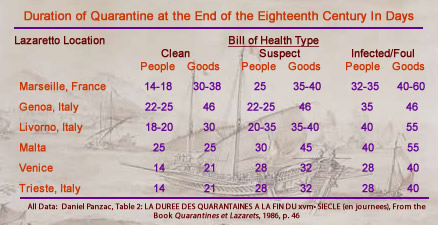
Duration of Quarantine at the End of the Eighteenth Century in Days
Image Artist: Pierre Puget - Ship at Marseille (c. 1651-4)
goods and people served different amounts of quarantine as well. Historian Daniel Panzac assembled an interesting list comparing the quarantine times for both people and goods for the late 18th century.19 It is included here, although it must be understood that, like some of the other sources used in this article, this represents a period fifty to seventy-five years after the golden age of piracy and may not necessarily be accurate for the period of interest. For example, there are places where ships in earlier periods with clean bills of health served no quarantine, while this chart shows every location having some quarantine period for people and goods on a ship with a clean bill of health. As such, it should only be used to recognize that different locations had different quarantine periods for goods and people.
1 Instruzzioni e gouerno del lazzaretto di Messina per la scala franca, 1695, p.6 - translated by the author; 2 John Evelyn, The Diary of John Evelyn, Edited by William Bray, 1901, p. 83; 3 Daniel Panzac, "Instruction pour les Intendants de la Sante Sur les Usages & Coutumes du Bureau [1716]", Quarantines et Lazarets, 1986, p. 134, translated by the author; 4 John Howard, An Account of the Principal Lazarettos In Europe, 1791, p. 19; 5 Eduardo Freire de Oliveira & Câmara Municipal de Lisboa, Elementos para a historia do municipio de Lisboa, Tomo X, 1899, p. 427-8, translated by the author; 6,7 Panzac, "Instruction...", p. 134; 8 Carlo M. Cipolla, Fighting Plague in Seventeeth-Century Italy, 1981, p. 38; 9 Cipolla, p. 72; 10,11 Instruzzioni e gouerno del lazzaretto di Messina..., p.8; 12 Howard, p. 18; 13 Howard, p. 19; 14 Howard, p. 18; 15,16 Panzac, "Instruction...", p. 134;17 Howard, p. 18; 18 Charles Savona-Ventura, Knight Hospitaller Medicine in Malta [1530-1789], 2015, p. 48; 19 Howard, p. 8; 20 Howard, p. 9; 21 See Panzac, p. 48

